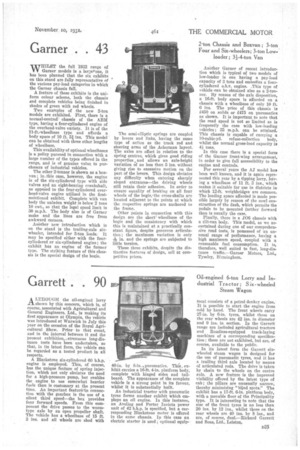Garrett . 90
Page 15

If you've noticed an error in this article please click here to report it so we can fix it.
ALTHOUGFI the oil-engined lorry ..shown by this concern, which is, of course, associated with Agricultural and General Engineers. Ltd., is making its first appearance at Olympia, the vehicle was introduced at Warwick in July this year on the occasion of the Royal Agricultural Show. Prior to that event, and in the interval between it and the present exhibition,, strenuous long-distance tests have been undertaken, so that, in its latest form, the vehicle can be regarded as a tested product in all respects.
A Blackstone six-cylindered 60 b.h.p. engine is employed. This, of course, has the unique feature of spring injection, which not only obviates the need for a high-pressure pump, but enables the engine to use somewhat heavier fuels than is customary at the present time. An important featurdiio connection with the gearbox is the use of a silent third speed—the box provides four forward speeds. From this component the drive passes to the wormtype axle by an open propeller shaft. The vehicle has a wheelbase of 15 ft. 3 ins, and all wheels are shod with
40-in. by 8-in.,pneumaties. This, exhibit carries a 16-ft. 4-in, platform body, complete with hinged sides and tailboard. The appearance of the complete vehicle is a strong point in its favour, whilst it is substantially built.
An industrial tractor with pneumatic tyres forms another exhibit which employs an oil engine. In this instance, an Aveling and Porter Invicta power unit of 42 b.h.p. is specified, but a corresponding Blackstone motor is offered in the same chassis. In this case an electric starter is used ; optional equip ment consists of a petrol donkey engine. It is possible to start the engine from cold by hand. The front wheels carry 27-in. by 6-in. tyres, whilst those on the rear wheels are 42 ins, in diameter and 9 ins, in section. In the Garrett range are included agricultural tractors and RoadIess-equipped track-laying machines of a corresponding specification; these are not exhibited, but are, of course, available to the public.
In its latest form the Garrett sixwheeled steam wagon is designed for the use of pneumatic tyres, and it has a trailing third axle located by means of articulated rods. The drive is taken by chain to the wheels on the centre axle. A new feature is the improved visibility offered by the latest type of cab ; the pillars are unusually narrow, thereby minimizing " blind spots." The exhibit has a 17-ft. 6-in, platform body, with a movable floor of the Principality type. It is interesting to note that the size of the front tyres is no less than 20 ins. by 12 ins., whilst those on the rear wheels are 40 ins. by 8 ins., and are, of course, dual.—Richard Garrett and Sons, Ltd.. Letzten.
















































































































































